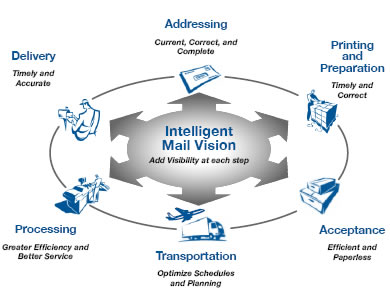
Addressing. Efforts to improve address quality will be enhanced with detailed feedback to mailers about out-of-date, incorrect, or incomplete addresses. Internal efforts have brought improvements to the AMS database. Tighter update requirements and systems tracking when address data is updated will bring these improvements to address lists.
Printing and Preparation. New containerization procedures and labels enable visibility and updated Intelligent Mail printing requirements will drive automation compatibility. PostalOne! documentation facilitates seamless acceptance and provides customers the status of mailings.
Acceptance. Mail acceptance is becoming streamlined, thanks to a seamless flow of information among customers, mail services providers, and the Postal Service. When mail is correctly prepared and documented, verification can be completed as mail is processed. Data on when mail first arrives at a postal facility will provide “start the clock” information for customer tracking and service measurement.
Transportation. Visibility tracks the movement of mail between operations and facilities whether in mailer or postal-provided transportation. FAST helps mailers identify the most appropriate entry points and schedule entry, and helps postal managers optimize resources. Embedded quality controls will reduce misdirected and misdelivered mail.
Processing. Better mail flow data will provide new ways to address quality problems and create new cost-saving opportunities. Data will enable broader service performance measurement. Mailers will be able to track their mail as it moves through the network, opening new opportunities to better serve their customers.
Delivery. Data at the point of delivery closes the loop. Data for parcels containing delivery and signature confirmation are captured at delivery; for letters, delivery is assumed on the day of DPS processing. Visibility systems will also enable processes to correct the many address and barcode quality issues that end up in delivery.
Testing conducted by the Postal Service and a contingent of flat mail printers answered many questions related to IM barcode printing specifications and the ability of high-speed ink-jet printers to meet them. Adjustments to the proposed print specifications resolved a number of issues and make it easier for mailers to convert. Technical discussions coming out of the testing are encouraging rapid industry conversion to IM barcodes. To ease the transition of mailers to encode and decode IM barcodes, the Postal Service has made encoder software available that supports multiple personal computer and mainframe platforms. For decoding, a barcode reader or software is required for conversion. Scanners have been provided to bulk mail entry units for data quality checks. In addition, an online solution is available at ribbs.usps.gov that can be used for manual, low volume barcode encoding and decoding.

